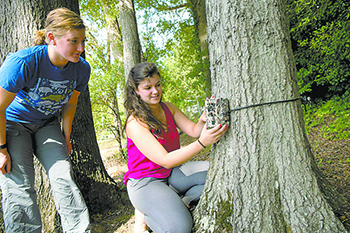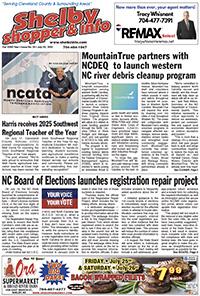 How would you like to explore the outdoors while learning about animals living in your own backyard? And what if you could do all that while helping scientists gain information that can be used to help conserve and manage local wildlife? If that all sounds good to you, then you are in luck! The NC Candid Critters project is working with citizen science volunteers of all ages and backgrounds to set camera traps (motion and heat sensitive trail cameras) to help scientists learn about the state's wildlife.
"Cameras are set out for three-week periods, and all images are reviewed and uploaded by citizen science volunteers," says Lexy Mash, volunteer coordinator for NCCandidCritters.org. "Participants can check out cameras through participating libraries across the state."
In our area, cameras are available from the Cleveland County Memorial Library (CCML).
"We started checking out cameras in March," says Meghan Blackburn, technical services librarian at CCML. "So far we have had 13 cameras checked out from the main branch in Shelby." Cameras are also available at the Kings Mountain and Spangler library branch locations.
Cameras borrowed through the program can be placed on pre-selected sites on public lands or on the participant's own land (residential yards are limited to one site/volunteer).
"We are interested in surveying a variety of sites across the state that include forested, open and developed areas," says Mash.
Those interested in participating will receive an official invitation after reserving a space on
www.nccandidcritters.org. After completing an hour-long online training course, volunteers who pass the online quiz will be contacted to pick up a camera at the library. (Volunteers can also purchase or use their own trap-camera. Visit www.nccandidcritters.org for a list of suitable camera brands.)
According to the website, scientific questions that the researchers are hoping to answer through this project include:
1. Is the deer population in NC increasing, decreasing or staying the same?
2. Where are coyotes and how abundant are they in NC?
3. Where are other species of concern in NC located? These species include bear, elk, weasels, fox squirrels, red squirrels, armadillos, woodrats, feral pigs, chipmunks and skunks.
After the cameras are retrieved following the three-week period, all images are reviewed and uploaded by the volunteers in a custom software program called eMammal.
"We use eMammal as an online database for our pictures; this is kind of like a digital filing cabinet for all the pictures collected by our project and other projects around the world," said Mash. "eMammal was developed with funding from the National Science Foundation."
Candid Critters is a collaboration between NC State University, NC Museum of Natural Sciences, NC Wildlife Resources Commission, the State Library of NC, NC Cardinal, the Public Libraries of North Carolina and the Smithsonian.
For more information, visit www.nccandidcritters.org or send an email to info@nccandidcritters.org.
By April Hoyle Shauf
Special to Community First Media |




